Waterfowl and Beyond
Ducks Unlimited's conservation work provides a host of benefits in addition to more ducks and geese
Ducks Unlimited's conservation work provides a host of benefits in addition to more ducks and geese
By Mike Brasher, PhD, and Ellen Herbert, PhD
"ALTHOUGH WATERFOWL HAVE BEEN THE MOTIVATION FOR DU'S FUNDRAISING, SCIENCE, AND CONSERVATION OF MORE THAN 14.5 MILLION ACRES OF HABITAT ACROSS THIS CONTINENT, PEOPLE AND OTHER WILDLIFE DERIVE MANY OTHER BENEFITS FROM OUR WORK AS WELL."
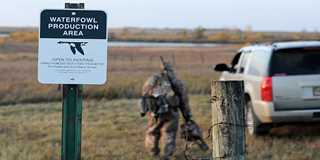
Photo Jim Thompson
Since its founding in 1937, Ducks Unlimited's conservation mission has been fueled by a passion for abundant waterfowl populations and the unwavering desire to share these resources with future generations. For longtime DU members and supporters, this mission is well understood and deeply ingrained. While we have traditionally measured our success by counting acres, ducks, and dollars, there is much greater value in our conservation legacy than many realize.
Perhaps you've noticed that, like mallards, floodwaters do not recognize political boundaries, property lines, or human motivations. Instead, the movements of waterfowl and water are shaped by the landscape, by the topography and weather, and by the habitats that are created when rainwater settles into potholes or spills over riverbanks into adjacent bottomlands. Wetlands not only provide habitat for waterfowl and other wildlife but also hold back storm water and filter out pollutants. Although waterfowl have been the motivation for DU's fundraising, science, and conservation of more than 14.5 million acres of habitat across this continent, people and other wildlife derive many other benefits from our work as well.
Gifford Pinchot, the first chief of the US Forest Service and an iconic figure in the history of natural resource management, was an influential voice in crafting the modern-day definition of conservation as "the wise use of the earth and its resources for the lasting good . . ." This view reflects the belief that although conservation actions are defined by the ecology and needs of wildlife, plant communities, and ecosystems, our interest in conserving these resources exists because people care about and derive value from them. In similar fashion, people are ultimately afforded the collective rewards of DU's conservation work, both directly through interactions with the natural world and indirectly in ways that are often unappreciated. Public opinion polls consistently show broad support for conservation, demonstrating that nature is indeed a galvanizing force and common interest across many segments of society. A 2012 bipartisan survey revealed that over 80 percent of respondents, regardless of political affiliation, viewed natural resources conservation as patriotic. A 2016 survey by the Pew Research Center found that 74 percent of Americans believe it is important to protect the environment.
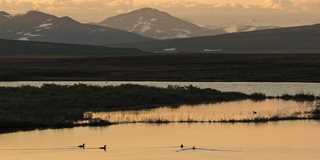
Photo Ken Archer
Given that DU's primary interest is conserving habitat to benefit waterfowl populations and the people who care about them, why all the fuss about the other benefits and services provided by our conservation work? Simply put, the loss and degradation of wetlands and other waterfowl habitats are occurring at a rate and scale that challenge our ability to offset them based solely on their value to waterfowl. North America's prairie grasslands and wetlands, for example, which provide vital nesting cover and breeding habitat for ducks, also represent one of the most endangered ecosystems on earth. In the US Prairie Pothole Region, more than 73 percent of historical grasslands have been converted to other land uses, and these losses continue at an alarming rate.
In Canada, where wetland protections have been historically lacking or remain weak, up to 70 percent of wetlands in settled regions have been lost or degraded. In the continental United States, more than 50 percent of historical wetlands have been drained, filled, or converted to other uses. And in states such as California, Illinois, Missouri, and Ohio, wetland losses exceed 85 percent. Coastal wetlands provide another stark example of ongoing wetland loss and degradation. In south Louisiana, more than 1.2 million acres of coastal marsh have been claimed by saltwater intrusion, natural subsidence, and rising sea levels since 1932. Another 1.4 million acres are expected to be lost within the next 50 years.
To address the growing threats facing wetlands and other waterfowl habitats, we must expand and accelerate our conservation delivery, which will require us to grow our base of support. The many benefits provided by our wetland and grassland conservation work have long been recognized by DU, but we must now communicate those benefits to a broader audience. We must be just as vocal and passionate about the value of our work to other wildlife, ecosystems, and people as we are about its importance to waterfowl. The more people understand how waterfowl habitat conservation improves their lives, the more support and investment we will receive for our mission. Let's take a closer look at some of the many benefits derived from DU's conservation work for waterfowl and much more.

Photo 6 Drakes Photography
We see abundant evidence that conservation delivered on behalf of waterfowl also benefits other birds. On the prairies, ring-necked pheasants, sharp-tailed grouse, and dozens of species of migratory songbirds and shorebirds respond favorably to wetland and grassland conservation efforts. Studies in the northern Great Plains showed that pheasant populations grew rapidly in response to the restoration of upland cover through the Conservation Reserve Program, increasing by an impressive 22 percent in response to a 4 percent increase in grassland on the landscape.
Moreover, research from the Canadian prairies confirmed that landscapes containing high densities of small wetlands, which support large numbers of breeding ducks, also support a greater abundance and diversity of other bird species. In addition to providing places for people to hunt and fish, wetlands are popular spots for bird-watching. One needs to spend only a few minutes by a shallow wetland or tidal marsh to observe long-legged waders, elegant shorebirds, and curious marsh birds alongside waterfowl.
Wetlands are essential ecosystems for a diversity of species, including waterfowl and fish. Although conflicts have sometimes occurred between waterfowl and fisheries interests in the past, these groups are now working together to find areas of mutual gain, and Ducks Unlimited is proud to support these efforts. One innovative example comes from California's Central Valley, where DU is partnering with California Trout and the California Rice Commission to demonstrate how winter-flooded rice fields can serve as surrogate wetlands for juvenile salmon in areas where natural floodplain habitats have been lost. In fact, researchers discovered that salmon raised in flooded rice fields were larger on average than those raised in streams and rivers.
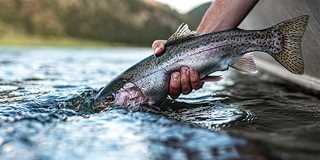
Photo Montana Outdoor Imagery
Across the Great Lakes region, DU routinely incorporates fish ladders and shallow spawning pools for northern pike into its wetland restoration projects. Along our coastlines, marshes and sea grass meadows are among the most productive nursery habitats for estuarine and marine fish, supporting more than 70 percent of the commercial fish catch and over 80 percent of the recreational catch from these waters. On the Texas Gulf Coast, DU partnered with the Coastal Conservation Association to restore sea grass meadows on a degraded site near Port Aransas, providing improved foraging habitat for wintering redheads and prime nursery habitat for juvenile redfish. Waterfowl and fish benefit from these habitat restoration efforts, but so do anglers, waterfowl hunters, bird-watchers, and others who venture afield in coastal areas.
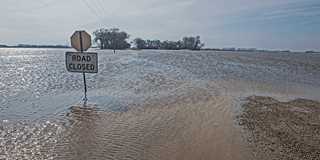
Photo TODDSTEELEPHOTOART.COM
While Ducks Unlimited continues to expand its partnerships with groups dedicated to conserving habitat for fish and other wildlife, tremendous potential also exists to garner even more support for our mission by promoting the broader ecological benefits of our work. Among the most well-known of these "ecosystem services" are the roles that intact wetlands play in storing floodwaters and purifying water by removing excess nutrients from storm water and agricultural runoff. Dense stands of marsh grass and upland vegetation slow the flow of water and trap sediment from runoff, and dense mats of decaying plant material in the soil absorb water like a sponge. Research conducted by the US Geological Survey on Glacial Ridge National Wildlife Refuge in western Minnesota found that the restoration of cropland to native prairie reduced overland runoff by 33 percent while also increasing groundwater recharge by 16 percent. In addition, nitrate (derived from nitrogen fertilizer) and sediment in surface water both declined by over 50 percent, illustrating that a small increase in habitat packs a powerful punch in reduced flooding and improved water quality for people living downstream.
Conversely, widespread wetland drainage exacerbates downstream flooding on a massive scale. For example, studies have linked patterns of prairie wetland loss with long-term increases in flow rates in northern tributaries of the Mississippi River. In addition, the separation of the Mississippi from its historical floodplain has made downstream communities even more vulnerable to flooding. The physics are straightforwardwhen wetlands are drained or reduced in their capacity to hold water, Newton's law of gravity takes over, sending floodwaters as well as sediment and nutrients downstream in greater volumes than would occur naturally. DU's wetland conservation efforts help preserve or reestablish these water-holding capacities, reducing the risk of flooding and improving water quality. In the southern reaches of the Mississippi Flyway, a 1990s study supported by DU showed that winter flooding of harvested rice fields not only provides crucial habitat for waterfowl and other migratory waterbirds but also significantly reduces soil loss into streams while moderating nutrient releases and improving water quality.

Photo Ethan Massey, DU
With a growing scientific understanding of the ecological benefits provided by wetlands and grasslands, DU is forming new partnerships to conserve these vital habitats in watersheds across the nation. In Green Bay, Wisconsin, DU helped NEW Water, the municipal water authority, restore 29 acres of wetlands and 53 acres of grassland to store storm water and reduce sediments and nutrients flowing into the Duck Creek Delta of Green Bay. This project alone stores an estimated 20 million gallons of storm water and captures 100,000 pounds of sediment, improving water quality throughout Green Bay, where DU has completed many other coastal wetland restoration projects. DU is also a partner in watershed conservation work on other historical waterfowl staging and wintering areas like Lake Erie and Chesapeake Bay. In these watersheds, wetland restoration has become an increasingly popular way to improve water quality. By providing sources of clean drinking water, outdoor recreation, or habitat for economically important fish and wildlife populations, the benefits of DU's conservation work extend well beyond their points of origin.
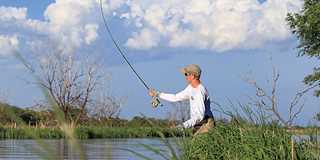
Photo DOUGSTEINKE.COM
In addition to the many ecosystem services provided by Ducks Unlimited's work, wildlife habitat conservation is an important driver for the economy. According to a survey conducted by the Outdoor Industry Association, nearly half the US population144 million peopleparticipated in at least one outdoor activity in 2016. Those activities generated $887 billion for the outdoor recreation industry and supported 7.6 million American jobs. In addition, the US Fish and Wildlife Service reported that in 2016 over 103 million Americans participated in fishing, hunting, bird-watching, or other forms of wildlife-associated recreation, which contributed more than $156 billion to the US economy.
The restoration of wetlands and other wildlife habitats by DU and its partners also contributes directly to local economies through expenditures on materials and labor. After habitat work is complete, the economic benefits continue through outdoor recreation, nature-based jobs, and other services that support nearby communities. In the past year, DU's conservation work has supported more than 1,540 construction contractors, engineers, suppliers, and other workers while injecting over $81.4 million into local economies. Moreover, these jobs and dollars stay local. For example, the nonprofit organization Restore America's Estuaries reports that for every dollar spent on habitat restoration in Oregon, 80 cents stay in the county where the project was completed, and 90 cents remain in state. These examples clearly demonstrate that investments in habitat conservation are also investments in local and national economies.
There exists a concept in ecology known as "mutualism." It refers to a situation in which two or more species interact to derive mutual gain. Although DU will always remain true to our mission of providing habitat for abundant waterfowl populations, the concept of mutualism can also be applied to DU's newfound relationships with partners that value our conservation efforts for the many benefits they provide beyond waterfowl. Now, in the summer of 2020, perhaps more than at any other time in our lives, we are reminded of these benefits and the comforting power of nature, which are products of DU's conservation work. In the days ahead, whether our adventures lead us to open grasslands, coastal marshes, prairie potholes, northern forests, or southern swamps, we should remember that as supporters of waterfowl conservation we also support clean water, flood protection, enhanced fisheries, resilient economies, and many other services to society and the world. For our role in this regard, we should be immensely proud, just as we take pride in 83 years of progress in our mission to fill the skies with waterfowl.
Dr. Mike Brasher is waterfowl scientist and Dr. Ellen Herbert is ecosystem services scientist at DU's national headquarters in Memphis, Tennessee.
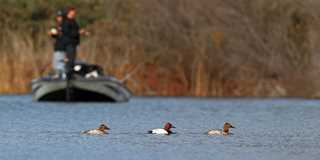
Photo Michael Peters
Ducks Unlimited uses water-control structures on many of its wetland restoration projects to regulate water flows and depths at optimal levels for waterfowl and other wildlife. If they are not designed properly, however, these structures can prevent fish from accessing wetlands, which can provide crucial spawning and nursery habitat for salmon, trout, and many other fish species. As a result, DU incorporates fish ladders and other design modifications in its water-control structures to give fish safe access to its wetland restoration projects.
DU Canada recently conducted research to compare fish passage rates and efficiencies between several types of water-control structures.
Researchers used passive integrated transponder tags embedded in individual fish (alewives) to measure their passage rates through different structures, which enabled the scientists to identify the most effective design. This work epitomizes how DU uses science-based information to maximize the benefits for not only waterfowl but also fish and other wildlife through its conservation work across North America.
Ducks Unlimited uses cookies to enhance your browsing experience, optimize site functionality, analyze traffic, and deliver personalized advertising through third parties. By continuing to use this site, you agree to our use of cookies. View Privacy Policy